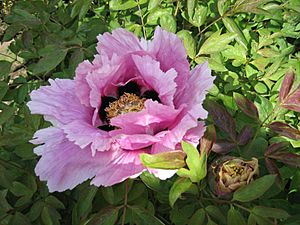Herbaceous plant facts for kids
A herbaceous plant is a type of plant that doesn't have a lot of wood. Its stems are usually green and soft, not hard and woody like a tree trunk. These plants grow quickly and produce many flowers and seeds in a short time.
In Botany, which is the study of plants, the word for a herbaceous plant is herb. This word comes from the Latin word herba, meaning "grass." However, people often use the word "herb" to mean plants used in perfumes, medicines, or for cooking, even if they aren't technically herbaceous plants.
Contents
Life Cycle of Herbaceous Plants
Herbaceous plants can live for different lengths of time. They can be annuals, biennials, or perennials.
Annual Herbaceous Plants
Most herbaceous plants are annuals. This means they complete their entire life cycle in one growing season. They sprout from a seed, grow, produce flowers, fruits, and seeds, and then die. They leave their seeds in the soil, which will grow into new plants when the weather is good. Wheat and pea plants are good examples of annual herbaceous plants.
Biennial and Perennial Herbaceous Plants
Biennial herbaceous plants live for two years. In the first year, they grow leaves and store energy. In the second year, they flower, produce seeds, and then die.
Perennial herbaceous plants live for more than two years. For both biennials and perennials, the parts of the plant above the ground (the stems and leaves) usually die back each year. However, their underground parts, like roots and special underground stems, stay alive. These underground parts can survive bad weather, like winter or very dry seasons. They then grow new stems and leaves above ground when conditions improve. Bulbs are examples of biennial plants, and peonies are perennial herbaceous plants.
Size and Habitat
Most herbaceous plants are small and have thin stems because they don't have much wood. But there are some big exceptions! For example, Banana plants and papaya plants (a tropical fruit) are actually herbaceous plants. Even though they look like trees, their stems are thick but don't have much wood.
Herbaceous plants are often the first plants to grow in barren lands, which are places without much plant life. This is because they are small and produce many seeds, making it easier for them to spread. You can also find them in places where the weather is tough for most plants. They can use the small amount of rain that falls in deserts. They can also get enough heat to grow where the soil is covered with snow and ice for most of the year, like in very high mountains.
Images for kids
See also
 In Spanish: Hierba para niños
In Spanish: Hierba para niños




